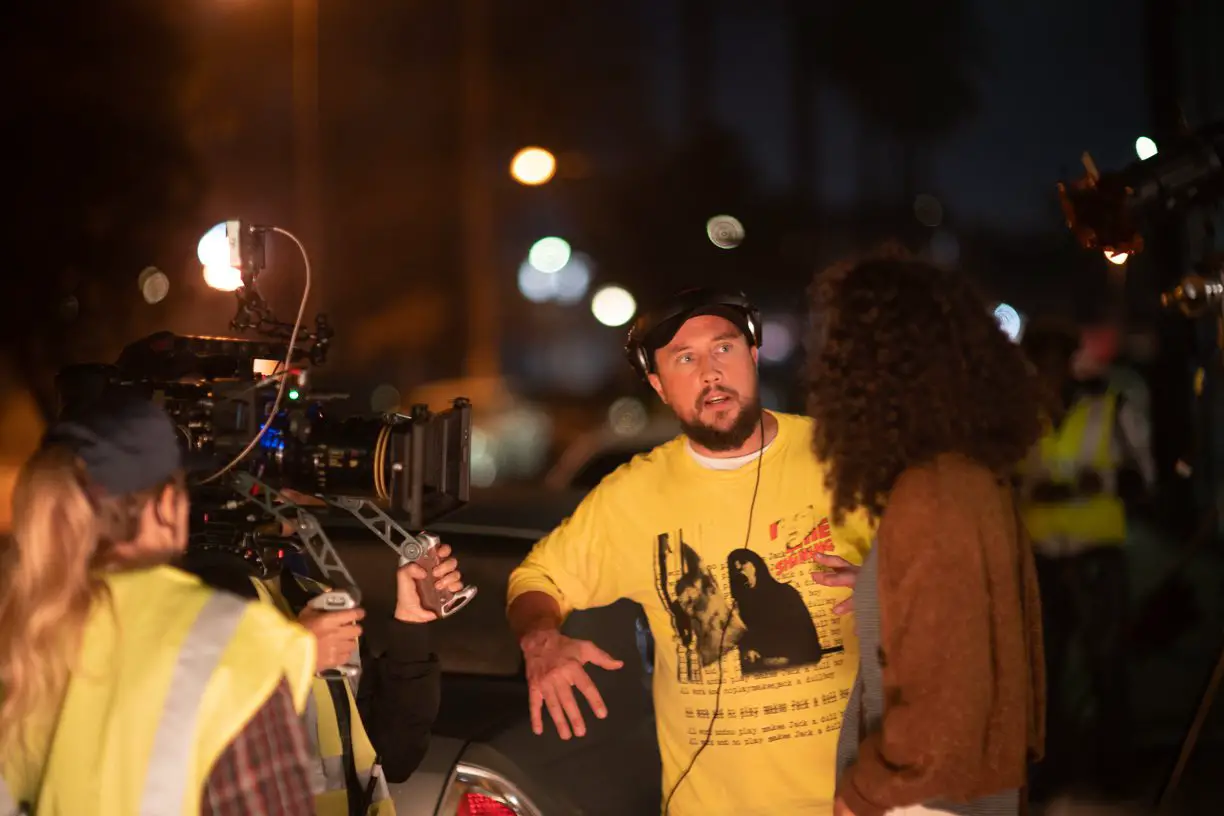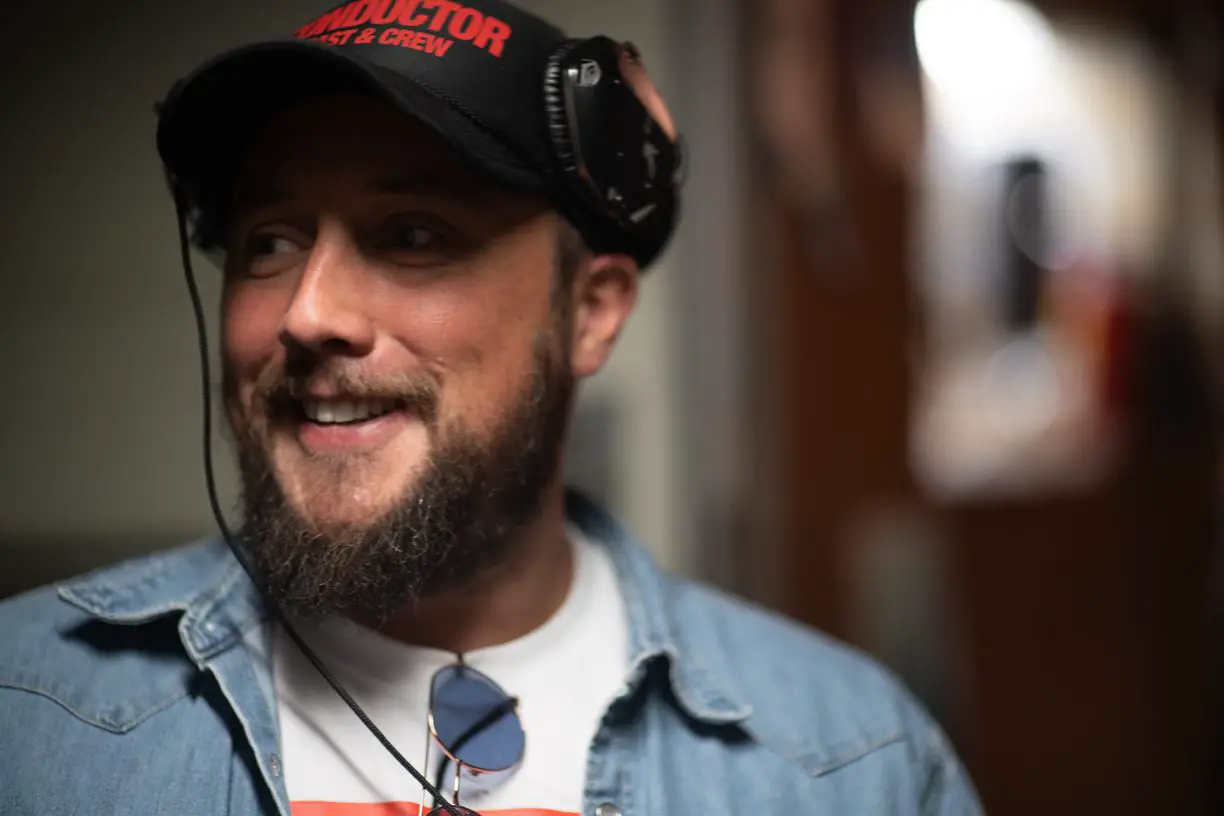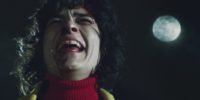A few short films that I’ve seen at film festivals have stuck in my head over the years, just a few. One of those was Alex Noyer’s Conductor, about a musical young woman, a competitive young man, and a drum machine that she knows her way around better than he does. The young woman in question left the film after less than seven minutes, with a swagger and a smile, and I looked forward to seeing her again when I discovered Alex had devised his first feature-length film from the same idea. So even before watching the film, I asked Alex’s publicist if I might interview him.
Alex was chuffed to discover I remembered Conductor from Grimmfest. “I love that festival,” he said. “I love Simeon [Halligan] and the whole team.”
Beyond Conductor, though, I knew very little about Alex, and so asked him about his career. “I’ve been a producer for seventeen years. For the bulk of it, I was in documentaries. I started a production company back in 2004—here in London, actually—and really made my career first in commercials, music videos and then in 2008 delved into feature documentaries. This escalated and, three short and two feature documentaries later, I had made a movie called 808, about the legendary 808 drum machine, which we played at South by Southwest 2015. That’s the peak of my documentary career. After that, I decided to shift into my lifelong passion of horror; actually, that was my wife who encouraged me to do that because she knew I needed a new challenge, so she said, ‘Why don’t you do what you love?’ That was great advice, coming from my darling wife. So after an obsession with the 808 drum machine, a lightbulb came on, and I decided to kill somebody with a drum machine, and that was Conductor. I’m a French-Finnish movie nerd, and I humbly try to tell creative stories, and in this case the story of an artist with great collateral carnage.”
That’s one way to put it!
Alex had mentioned an obsession with a drum machine. I asked whether he is a musician himself or simply a fanboy. “You know, the obsession really got galvanised by the fact that the movie 808 took five years to make. So that legendary drum machine took over my life. But no, I’m not a musician. I’m music-obsessed. I was a DJ, once upon a time, but not a very good DJ. The reason why people liked what I played was basically the diversity of the music I played, and my taste got me played in quite big venues. But I just love music. Through the production company, we’ve gotten to make a lot of music videos (I produced those, didn’t direct any). And just the junction of both [horror and music] made sense, taking those first steps into directing, directing a horror movie, in particular, felt like it was meant to be.”
As a fan myself—of Conductor rather than the tech behind it—I had a question I’d been itching to ask: why didn’t he use Kelli Jordan as Alexis again? “There are a lot of factors,” Alex said. “Casting this feature was obviously a complex system, and the movie is very different from the short, so we had to start from scratch. I worked closely with our casting director to see how we could build. And when it was suggested to me that I meet Jasmin [Savoy Brown], who I’d already seen and loved in The Leftovers, I just had to meet her; and in the reimagining of the story, I felt that I had met Alexis in Jasmin. I adore Kelli, and I adore what she did, but she’s doing great things right now, so I’m very excited for her.”
So this Alexis was a different personality, which meant it made sense to pick a different actor? “It was impossible to take the same approach. I had to reimagine the universe. That’s why the story of the short isn’t in the feature: the dynamic is different, the approach we took, the angle, the perspective; Alexis is a lot more elusive in the short, whereas in the feature, we are with her. And I had to create something that remained in the essence of the character but created something altogether different. I couldn’t do the six-minute short in ninety minutes, or the same kind of treatment. So we started from scratch, and it was a deep dive to create something that hopefully compels and motivates and convinces the audience.”
As for Sound of Violence, I asked how much research was involved in the writing; the film features subjects such as synaesthesia and trauma, after all. “A lot,” responded Alex. “I felt that I had to keep an open mind while writing the script and keep it as an open narrative with open questions on topics such as loss of hearing, which is different from deafness, and different from synaesthesia. The same thing with the role of a queer Black woman is in the core of my story. All those things which are written as open questions are written as such because they allowed me to seek authenticity. To seek authenticity, we reached out to consultants to know that, for example, the difference between deafness and loss of hearing: Alexis has lost her hearing, she wasn’t born like that, and so the way she signs is clumsy, and that’s normal. All those deliveries were researched because the only way to be authentic is to ask questions. So I wanted to ask questions.

“The identity of Alexis is something that came to my mind, and in order to do that, I needed to have an actress who identified as a queer Black woman herself: that’s Jasmin, a notorious activist in those areas, and who demands authenticity in her movies. That’s how she refers to herself and her character. My casting director believed in those ideas and believed we needed to maintain that authenticity. Similarly, behind the scenes, we had a crew made up of 60% women, with diversity throughout; not everyone was American. We made the best out of what Los Angeles represents and tried to make something that came together, and I was so humbled when Jasmin posted on her social media that this was the safest, most diverse and inclusive set she’d ever been on. And I think that shouldn’t be an exception.”
Having watched the film full of colours and images representing Alexis’ synaesthesia, I wondered where they had come from, too. “We had to find a way to visualise the experience that Alexis has, when she hears those sounds, not just saying, ‘She feels this way.’ The idea to explore synaesthesia came about because in my mind it is an ability, not a condition—an ability to visualise sounds and experience them in a way that we don’t. We hear them, and we can sometimes feel them, but if we can visualise them too, it’s a different experience. So I started to research artists—there’s an artist called Melissa McCracken who paints what she hears in music—and it allowed me to understand that synaesthetic abilities are different for everyone who has them. Generally, it’s not the same triggers, it doesn’t manifest itself; sometimes it’s just lights, sometimes just colour, like a screen going red or green when they hear certain sounds.
“That allowed me to create something based on Alexis, something vivid. Maybe because of my Nordic origins, I couldn’t help but think of Northern Lights; I pictured the idea that she saw Northern Lights with the sounds. And with that experimentation we did, it allowed us to create something that would immerse the audience in what she feels. And jokingly, we often ask, ‘Can you see what she feels?’ And with synaesthesia, you can. On a practical side, my unbelievable cinematographer Daphne [Qin Wu] took on the challenge. I knew she could work with colours and lights and placing in the rooms in ways that were interesting. We had to create first on set a lit environment from the back to the front so that when we laid the visual side of the lights, we had almost a backdrop if you will. We used some tricks like neon tubes that we could programme colours for, and I would be dancing in front of Jasmin with those tubes to project the light on her to project the dynamic because I didn’t want it to be static. And I didn’t want it to be just pink and blue because so many movies have those; I just wanted to create something that changed, so we put them on random sometimes, and I would be literally like a raving dancer with big glow sticks in front of her like that to create this projection. And then it allowed us to create the additional digital side, using visuals that take us away.
“The importance with synaesthesia is that this is her motivation encapsulated into a visual form, so we wanted to create something palpable and also clearly show to the audience that she is not connected to death, she is connected to what she hears. She never turns towards the victims but looks away, towards her instruments. This is why, when it comes to the gore, we make it a sort of backdrop away from what she is experiencing, with explosive reactions to show how vivid and intense it feels to her. Also, sometimes when the feeling drops, we get her to turn around and face her guilt.”
After that insight into the visual side, I had to ask Alex what it was like to work with his composers, of which there were three. Did he work with them first and add the images afterwards, or did they respond to the visuals? “A bit of both actually,” said Alex. “Jaakko Manninen also did the music for the short. Then we brought in Alexander Burke, who’s more of an instrumentalist. He has a mastery of instruments which allowed us to use instruments in the murders because of tapping into his craft to add to Jaakko’s production. And then Omar El-Deeb, who is a score composer, which allowed us to create this dynamic of all these elements that worked together. Furthermore, Jussi Tegelman who mixed the movie—a regular collaborator of Sam Raimi’s and who also worked on the short, very kind of someone with his experience and talent to collaborate with and help his fellow Finns, on such crazy creations—he embraced the challenge. I set out to them a challenge of shifting the paradigm between music and murder, changing music into weapons. You know, they first thought I was completely crazy, but they also enjoyed the challenge and the fun it was to just push it, push the experimentation.”
Alexis’s character, her compulsions, her reactions—all of that did come across as authentic to me when the music was being created. After the music went off and the police were there, I felt the authenticity faded away somewhat. I asked Alex to reconcile that if he could. “I wanted to create a police force that was unable to even get close,” he answered. “And the reason why they are there is because it is important to stay grounded. I know some people call it ‘procedural,’ but I feel that it was important to create essentially a metronome with the police: it was a pacing delivery to push Alexis in the midst of her escalation, with a sense of things fleeting. That and the loss of hearing are pace-setters, so I decided to create that, and it was less to create a sense of threat to Alexis but again to contextualise the timing. She has obviously spent years preparing this, and her escalation is not sudden. In the midst of everything, she starts to lose her hearing again, and that is what boosts that escalation. So that means she has to do it now, and in doing that, it would be wrong to have no sense of consequences.”

Here, we had a difference of opinion (which I do try not to bring into interviews), but Alex put me straight. It seemed to me that when the music stopped and Alexis stepped away from her creation, she didn’t think about it any longer, hence leaving evidence behind. “I disagree,” said Alex. “I think she does an incredible job: all the wires and everything is gone, and what she is leaving is completely print-free. She isn’t going to take the studio soundboard with her. She douses it with bleach. Sometimes people compare my movie to Saw, which I disagree with, but I’ll say it is funny that Jigsaw was given a lot more merit despite leaving a lot more mess than Alexis. I think Alexis is quite proficient in what she does: what she leaves behind is just what she cannot take with her.”
Stepping back from Alex’s own films, I asked what films had influenced him. “My favourite movie of all time is A Clockwork Orange,” he said, most decisively. “I was twelve years old when I saw it and it was a cathartic experience. My favourite horror movie, or rather my gateway into horror is Night of the Living Dead. I watched that when I was nine years old. And I followed that by watching Sam Raimi’s Evil Dead when I was ten: that’s what buckled me in, took the handbrake off and sent me into horror with open eyes and blew my mind. Movies like Battle Royale; I love Battle Royale. Then on a more human level, there are movies like The Diving Bell and the Butterfly that will always be a great example of how emotional movies can be and how far they can take you into someone’s experience. We talked about my representation of disability, which is something that we researched deeply and did with respect, and I was very happy with the response we got from the deaf communities for whom I was hoping to get it right. When you look at The Diving Bell and the Butterfly, I thought it was also an incredible movie because of how immersive it was and how they tried to get it right. I hope movies like that influenced me.
“On this film specifically, I think American Psycho had an impact. It’s a movie I love and a book I love— the same story, but two different experiences. I also thought about movies like Assassination Nation, which I thought was one of the most underrated movies of 2017. It was sold as a sort of teenage Purge but it wasn’t. It was more about identity crisis and so filled with representation. Like I said before, authenticity was important to me, and I did my research to make sure I could go where I wanted to go. This is where Assassination Nation inspired me. We have to have the ability to embrace wholly the environment we’re in—not just the story, but the context—so I really admire filmmakers who give real context. Especially as the father of two daughters, if I’m going to continue making female-led horror (which is very much my ambition), I want to try to get it as right as I can, because my daughters may not forgive me if I mess it up.”
The UK premiere of Sound of Violence features at this year’s FrightFest and then has its home release the following week. I asked Alex how he feels now that Alexis is going out into the world. “I’m very excited to have it released in the UK: it’s like a homecoming for me. Many people in the USA noticed perhaps British influences in what I do, perhaps because I lived here for fourteen years. It was also where my career blossomed. I’m humbly asking the audience to meet Alexis and give her a chance. I don’t want them to think I’m asking them to sympathise with her, but she is a lovely character who does unspeakable things. I hope that conflict is something the audience is willing to go through, to feel conflicted with her and about her. Don’t sympathise with her, but don’t rule her out. If you can keep some open-mindedness, you’ll have fun. It’s a fun movie, after all; we’re not taking anything over-serious (apart from the efforts of authenticity and diversity), but the fact is that this is an experimental opus for me. I’m hoping the journey of an artist can be seen in a horror context.”
Alex didn’t want to say goodbye without appreciating again that I had remembered and loved Conductor. “It means a lot because that film has obviously a special place in my heart […] It was the first thing that I directed, and when I hear the reaction it created and that you still remember it, that means the world to me.”
It’s one that I shared at the time with my non-horror-loving (then) husband, who was into music production, and he had appreciated it from that angle. “It’s funny how the music side allowed a non-horror audience to get into it,” commented Alex. “My best friend flinches at the sight of blood, and he watched it and started clapping! The fact that he hadn’t fainted was surprising, but you know, he liked it because of the musical side. That’s why I felt there must be something special in Alexis making music for murder.”
I had liked it especially for the character, who had a memorable sense of mischief and wit. “And dances away at the end,” added Alex. If you want to see what we smiled about, Conductor is available on YouTube.


